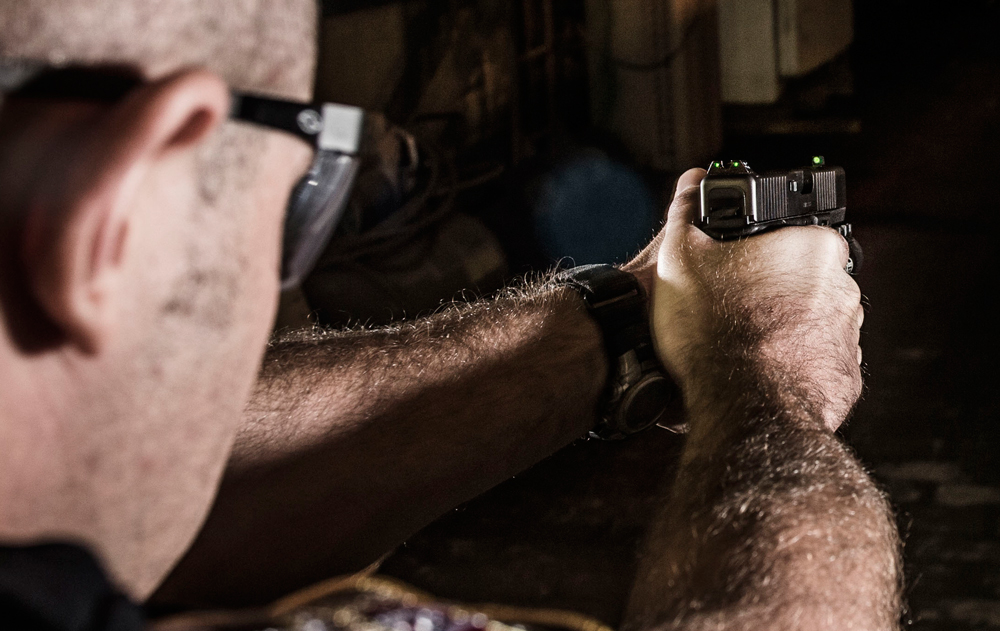At GunDigest, we independently review products. However, we may earn a commission when you purchase through links on our site. Learn More
Lighting Up Your Handgun with Tritium Sights

The trouble with most factory handgun sights is when it gets dark, you can’t see them, unless you possess infrared-detecting eyes. For those heat blinded members of society, like myself, then shoot for the tritium sights.
Of particular interest to those who purchase HD or SD guns is the existence of these “glow–in-the-dark” sights. While there are phosphorescent painted sights available (you shine a light on it for a few seconds and it glows), this is not the style of which I speak.
No, I mean the radioactivity glow-in-the-dark kind. I mean putting nuclear physics to work for little ole you. If the light is so subdued that you can’t see your sights, then you really can’t shoot effectively. Sights that are powered by Tritium are the solution. In the dark, these sights produce a low-power eerie glow that is easily seen in the dark and will not destroy your night vision.
It is difficult to overestimate the availability of tritium sights. There are tritium sights made for just about every handgun ever made. The commonality of 1911 pistols has generated a market all of its own, with no less than ten manufacturers offering tritium sights for that pistol.
For the most part you are looking at simple dots that illuminate in the dark and they are surrounded by a white ring for day usage. Actually the dots are constantly illuminated, but that illumination is washed out by daylight or by the intensity of the artificial lighting that most non-cavemen have come to appreciate, to the point that the enhancement can’t be seen except in very low light conditions. You don’t want them to be too bright or your own night vision will be ruined as well.
Instillation
You might find a sight slot that is loose fitting and the sight is held in by a set screw tensioned against the bottom of the slot. These sights are easy-peasy movable, but if that set screw walks your sight will just fall off. The large majority of sights are press fit into the sight slot and you will then have two not-so-great options for moving them, or for that matter installing them at all.
Let’s say that you want to do it yourself. The first option is to take a hammer and a punch (brass or plastic, NOT steel) and tap the sight out of its slot. Then you tap the new sight back in, preferably with the correct side with the dots facing the rear. Ahhh, crrraaaap!!! You went too far! Now you have to beat it back the other way, at which point you will go too far again. You do this a couple more times then take it to the range, shoot it, it’s still two inches to the right at ten yards, and you go back home and adjust it again. Pain in the old caboose, that is.
The second option is to purchase a sight pusher tool. There are some high-quality examples but the hitch is that they are easily as expensive as your new tritium sights, and with few exceptions, they are made unique to each gun. The Glock sight tool that I have works very well. But it is only made to use Glock factory sights and their unique shape, and Glock slides.
You can insert other sights but not as smoothly, since the contours on the sight engagement interface don’t match anyone else’s sights. Theoretically, other slides could be stuck on the tool, but again, not perfectly, and perfectly is the whole point to having a gun-specific sight pusher. These tools mitigate or eliminate damage caused by the switching process by exactly fitting the parts to be joined or separated.
The front sight on most pistols is inserted in a dovetail slot and should be drifted out gently to one side, according to the directions in the new sight package. Others need to be staked, like some 1911 front sights. Glock front sights are retained by a screw in the bottom of the slide roof that goes up into the sight body. Most replacement Glock front sights will come with a tool for installing this. You can also get one in the Wheeler Engineering screwdriver kit or from Brownells.
Editor's Note: This article is an excerpt from the book Maintaining & Accessorizing Firearms.
Next Step: Get your FREE Printable Target Pack
Enhance your shooting precision with our 62 MOA Targets, perfect for rifles and handguns. Crafted in collaboration with Storm Tactical for accuracy and versatility.
Subscribe to the Gun Digest email newsletter and get your downloadable target pack sent straight to your inbox. Stay updated with the latest firearms info in the industry.